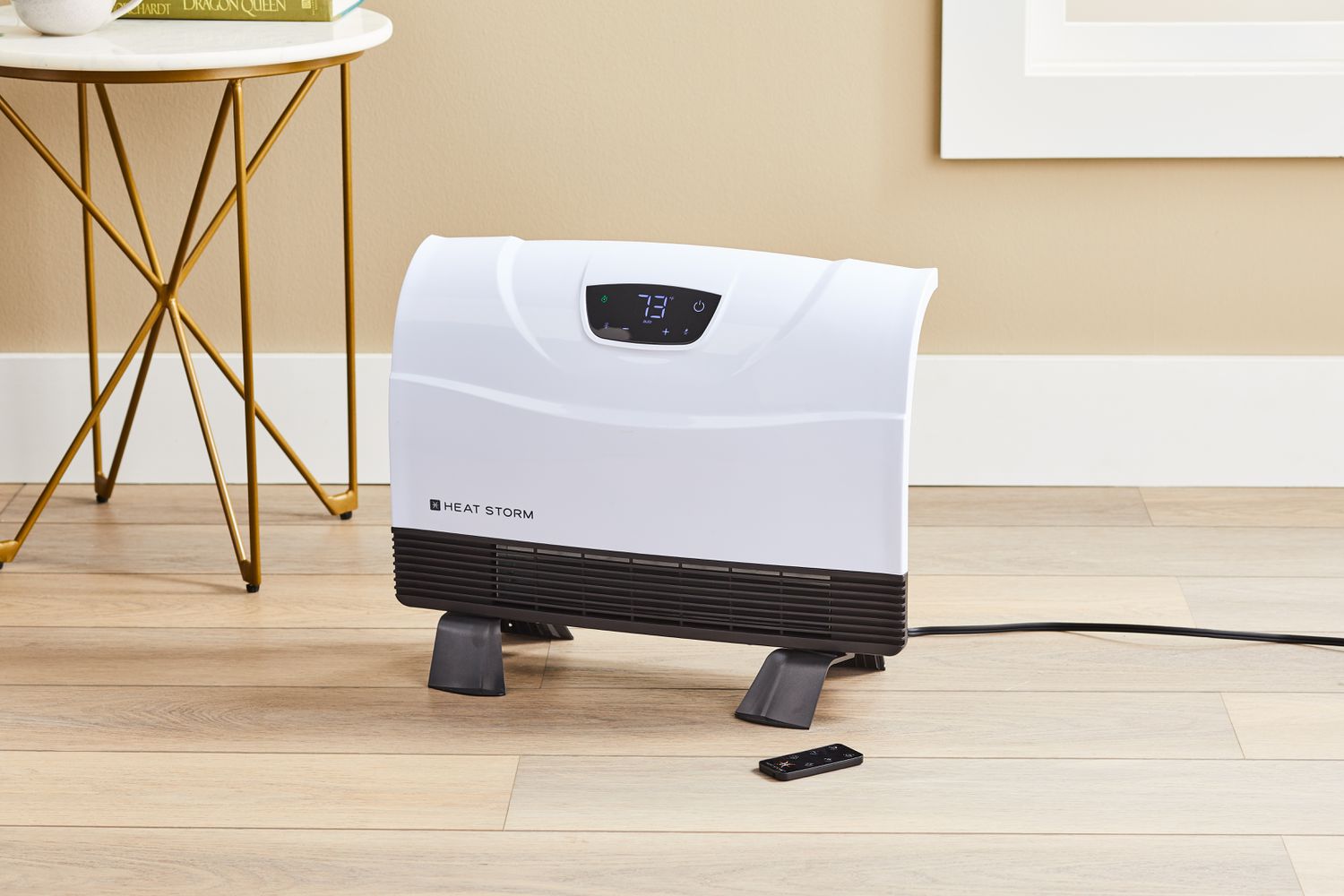Home Emprovement
Stay Warm and Eco-Friendly The Ultimate Guide to Choosing the Best Heater for Your Home

Choosing the right heater for your home is crucial for warmth, energy efficiency, and long-term savings. This guide simplifies the process by helping you understand your heating needs, explore various heater types, evaluate energy efficiency, and consider safety features. By the end, you’ll be well-informed to select the best heater for your home.
Understanding Your Heating Needs
Before you start shopping for a heater, it’s crucial to understand your specific heating needs. Various factors influence the type and size of the heater that’s best for your home.
Climate Matters
The climate in which you live plays a significant role in determining your heating requirements. If you reside in a region with harsh winters, you’ll need a more powerful heating system compared to someone living in a milder climate. Consider the average temperature and the length of the heating season in your area.
Room Size and Insulation
The size of the room you intend to heat is another critical factor. Larger rooms or open floor plans may require more substantial heating solutions. Additionally, the quality of your home’s insulation impacts how effectively heat is retained. Well-insulated homes require less energy to maintain warmth, whereas poorly insulated spaces may need more robust heating systems.
Personal Preferences
Your personal comfort preferences also matter. Some people prefer a warmer environment, while others are comfortable at lower temperatures. Consider any specific needs, such as allergies, that might influence your choice of the heater. For example, some heaters are better suited for people with respiratory issues because they don’t circulate dust.
Types of Heaters
There are several types of heaters available, each with its own set of advantages and disadvantages. Understanding these can help you make a more informed decision.
Electric Heaters
Electric heaters are popular for their convenience and variety. They come in different forms, such as baseboard heaters, wall-mounted units, and portable space heaters.
- Pros:
- Easy to install and use
- Portable options available
- Safe for indoor use
- Cons:
- Can be expensive to run continuously
- May not be suitable for large spaces
Gas Heaters
Gas heaters, including natural gas and propane heaters, are known for their efficiency and cost-effectiveness, especially in larger spaces.
- Pros:
- Efficient and cost-effective
- Suitable for larger areas
- Quick heating
- Cons:
- Requires a gas line connection
- Installation can be complex
- Potential safety concerns with gas leaks
Radiant Heaters
Radiant heaters work by emitting infrared radiation that directly heats objects and people in the room, rather than the air.
- Pros:
- Provides instant heat
- Energy-efficient
- Ideal for spot-heating
- Cons:
- Limited to heating small areas
- Can be a fire hazard if not used properly
Central Heating Systems
Heat pump types are versatile systems that can provide both heating and cooling. They are highly efficient and environmentally friendly.
- Pros:
- Energy-efficient
- Dual function (heating and cooling)
- Environmentally friendly
- Cons:
- Higher initial cost
- Requires professional installation
- Less effective in extremely cold climates
Energy Efficiency and Environmental Impact
Energy efficiency is a crucial factor when selecting a heater, not only for your utility bills but also for the environment.
Identifying Energy-Efficient Heaters
Look for heaters with high Energy Star ratings or equivalent certifications. These heaters are designed to use less energy while providing the same level of warmth. Pay attention to the heater’s wattage and efficiency ratio.
Environmental Footprint
Consider the environmental impact of the heater you choose. Electric heaters powered by renewable energy sources are more eco-friendly compared to those reliant on fossil fuels. Heat pumps and other systems that use less energy contribute to a smaller carbon footprint.
Long-Term Savings
Investing in an energy-efficient heater may have a higher upfront cost, but it can save you money in the long run through reduced utility bills. Calculate the potential savings over the lifespan of the heater to see if the initial investment is worthwhile.
Safety Considerations
Safety should always be a top priority when choosing a heater for your home. Here are some tips to ensure you select a safe and reliable heating system.
Safety Features to Look For
Modern heaters come with various safety features, such as:
- Overheat protection
- Tip-over switches
- Cool-to-touch surfaces
- Automatic shut-off timers
These features can prevent accidents and provide peace of mind, especially in households with children or pets.
Proper Usage Guidelines
Always follow the manufacturer’s instructions for safe operation. Avoid placing heaters near flammable materials, and ensure the heater is on a stable, flat surface. Regularly inspect the heater for any signs of wear or damage.
Ventilation and Maintenance
Proper ventilation is essential, especially for gas heaters, to prevent the buildup of harmful gases like carbon monoxide. Regular maintenance, such as cleaning filters and checking for leaks, can prolong the life of your heater and keep it operating safely.
New Technologies in Heating
The heating industry is constantly evolving, with new technologies making it easier to stay warm while being mindful of energy consumption and environmental impact.
Smart Heaters
Smart heaters can be controlled remotely via smartphone apps, allowing you to adjust the temperature even when you’re not at home. They often come with programmable settings and learning capabilities, adapting to your schedule and preferences.
Eco-Friendly Solutions
Some of the latest heaters use renewable energy sources, such as solar power or geothermal energy. These options are not only sustainable but also help reduce long-term operational costs.
Integration with Smart Home Systems
Many modern heaters can be integrated into existing smart home systems, allowing for seamless control alongside other smart appliances. This integration can lead to more efficient energy use and greater convenience.
Cost Analysis
When choosing a heater, it’s essential to consider the overall cost, including the initial purchase, installation, and long-term operational expenses.
Initial Purchase Cost
The price of heaters can vary widely depending on the type and brand. While electric heaters are generally less expensive upfront, more advanced systems like heat pumps may require a higher initial investment.
Installation Costs
Installation costs can add significantly to the total expense, especially for gas heaters or complex systems like heat pumps. Be sure to factor in these costs when budgeting for your new heater.
Long-Term Operational Costs
Energy-efficient heaters may cost more initially but can save you money on utility bills over time. Consider factors such as energy consumption, maintenance, and potential repairs when evaluating long-term costs.
Conclusion
Choosing the right heater for your home is a significant decision that impacts your comfort, energy consumption, and environmental footprint. By understanding your heating needs, exploring various heater types, evaluating energy efficiency and safety features, and considering costs, you can make an informed choice that aligns with your values and lifestyle.
Home Emprovement
Raynor Traditional Garage Doors: A Blend of Style and Durability

Introduction
Garage doors play a crucial role in enhancing a home’s curb appeal, security, and functionality. Among the numerous options available, Raynor traditional garage doors stand out for their superior craftsmanship, timeless design, and advanced security features. Whether you are looking to upgrade your existing garage door or install a new one, Raynor offers a variety of choices that cater to different preferences and needs.
This article explores the benefits, features, and installation considerations of Raynor’s traditional doors.
What Makes Raynor Traditional Garage Doors Stand Out?
Raynor traditional garage doors are known for their high-quality construction and elegant designs. They combine durability with aesthetic appeal, making them a preferred choice for homeowners. These doors are crafted from top-tier materials such as steel, aluminum, and wood, ensuring longevity and resistance to weather conditions. Moreover, Raynor offers multiple customization options, including colors, window designs, and panel styles, allowing homeowners to personalize their garage doors to match their home’s exterior.
Additionally, Raynor traditional garage doors come with advanced technology that improves convenience and security. Many models feature smart openers that allow homeowners to operate their doors remotely via smartphone apps. This integration makes it easier to monitor garage door activity even when away from home, adding an extra layer of security and peace of mind. The combination of design, technology, and customization makes Raynor an industry leader in garage door manufacturing.
Key Features of Raynor Traditional Doors
Raynor garage doors come with several impressive features that set them apart. These include:
- Insulated Panels: Raynor doors are available with insulation options, improving energy efficiency and reducing noise.
- Durable Materials: High-quality steel and wood options provide strength and longevity.
- Variety of Styles: Choose from colonial, carriage house, and ranch designs to suit your home’s architecture.
- Advanced Security Mechanisms: Equipped with strong locking systems, these doors enhance security.
- Weather-Resistant Coatings: Protect against rust, moisture, and UV rays for longer durability.
- Smart Technology Compatibility: Some models come with Wi-Fi-enabled openers for remote operation and monitoring.
- Smooth and Quiet Operation: Designed with noise-reducing components, these doors are ideal for households with attached garages.
These features contribute to the growing popularity of Raynor doors among homeowners who prioritize both style and practicality.
Benefits of Installing Raynor Traditional Garage Doors
Investing in a Raynor traditional door provides numerous benefits:
- Enhanced Curb Appeal: A stylish garage door can significantly improve a home’s appearance and value.
- Improved Insulation: Helps maintain indoor temperatures, reducing energy costs.
- Increased Security: Sturdy construction and locking systems provide enhanced protection.
- Minimal Maintenance: Durable finishes require less upkeep compared to other brands.
- Customizable Designs: Homeowners can select from various finishes, materials, and window inserts.
- Energy Efficiency: Insulated doors help regulate garage temperatures, reducing strain on heating and cooling systems.
- Higher Resale Value: An upgraded garage door can boost a home’s market value, making it a worthwhile investment.
Exploring the Versatility of Raynor Traditional Doors
Raynor traditional doors are versatile and suitable for different architectural styles. Whether you own a contemporary or classic home, Raynor has a range of traditional designs that blend seamlessly with any exterior. These doors are also available in multiple opening mechanisms, including roll-up, sectional, and swing-out styles, offering flexibility for different garage layouts.
Another aspect of their versatility is the ability to complement different landscaping and exterior elements. With a variety of finishes available, homeowners can match their garage doors to fencing, siding, or front doors for a cohesive look. This adaptability makes Raynor traditional doors a favorite among architects and designers who want to maintain aesthetic harmony while ensuring durability and function.
Installation and Maintenance Considerations
When installing a Raynor garage door, it’s essential to consider:
- Professional Installation: Hiring an expert ensures proper alignment and operation.
- Space Requirements: Measure your garage opening to choose the right door size.
- Regular Maintenance: Lubricate moving parts, check for wear, and clean the door periodically.
- Weatherproofing: Ensure seals and insulation are intact for energy efficiency.
- Safety Features: Opt for doors with automatic reversal systems to prevent accidents.
Routine maintenance plays a key role in extending the lifespan of a garage door. Inspecting the tracks for debris, ensuring springs are in good condition, and testing safety mechanisms can prevent potential issues. Homeowners should schedule an annual professional check-up to ensure optimal performance.
Cost and Warranty Considerations
Raynor traditional doors offer excellent value for money. The cost varies based on material, insulation, and design choices. Homeowners can expect:
- Affordable Pricing Options: From budget-friendly models to premium designs.
- Warranty Coverage: Raynor provides warranties on parts, materials, and performance.
- Energy Savings: Insulated models help reduce long-term energy expenses.
- Long-Term Investment: High durability means fewer replacements and repairs over time.
- Customization Costs: Additional design elements like windows or decorative hardware may affect the final price.
Many Raynor doors also come with extended warranties, providing peace of mind to homeowners. Understanding the warranty details before purchase helps buyers maximize their investment and plan for future maintenance needs.
Endnote
Raynor traditional garage doors are an excellent choice for homeowners seeking a combination of style, durability, and security. Their high-quality craftsmanship, customizable options, and energy-efficient features make them a standout option in the market. Whether you need a classic or modern look, Raynor’s traditional doors provide the perfect balance of aesthetics and functionality. Investing in a Raynor door ensures a long-lasting, visually appealing, and secure garage solution for your home.
By selecting a Raynor traditional door, homeowners benefit from enhanced property value, increased security, and long-term cost savings. Whether used for residential or commercial purposes, these doors are designed to withstand the test of time while providing superior functionality. If you’re considering upgrading your garage door, Raynor traditional doors are undoubtedly a top-tier option worth exploring.
Home Emprovement
Transform Your Living Space: The Ultimate Brampton Home Upgrade Guide

Introduction
Upgrading your home is one of the most effective ways to enhance comfort, functionality, and property value. Whether you’re looking to modernize your interiors, improve energy efficiency, or expand your living space, a well-planned home upgrade can make a significant difference. In Brampton, homeowners have numerous options to elevate their living spaces while keeping up with the latest design trends and smart home innovations.
This guide explores the essential aspects of Brampton home upgrade, offering insights into remodeling strategies, cost-effective improvements, and the latest trends in home renovations.
Key Considerations for a Successful Brampton Home Upgrade
Before starting any home improvement project, it’s crucial to outline your goals and budget. Are you looking to enhance curb appeal, increase functionality, or make your home more energy-efficient? Identifying your priorities will help you allocate resources effectively. Additionally, understanding local building codes and obtaining necessary permits is essential to ensure a smooth renovation process. Working with experienced contractors in Brampton can also help streamline your home upgrade project.
Another vital factor is planning for unexpected costs. Renovation projects often uncover hidden issues such as outdated wiring, plumbing problems, or structural weaknesses. Setting aside a contingency budget of at least 10-20% of your total renovation costs can help mitigate financial stress. Additionally, consider the long-term return on investment (ROI) when selecting materials and design elements to ensure your home upgrades add lasting value.
Modern Kitchen Upgrades: Elevate Functionality and Aesthetics
The kitchen is often the heart of the home, making it a top priority for upgrades. Modernizing your kitchen can include installing new cabinetry, upgrading countertops, and integrating smart appliances. Open-concept designs, energy-efficient lighting, and high-quality materials such as quartz or granite can add value and sophistication. If you have a smaller kitchen, optimizing storage solutions like pull-out shelves and multi-functional islands can maximize space.
Another emerging trend is the integration of eco-friendly materials and appliances. Energy-efficient dishwashers, refrigerators, and induction cooktops not only reduce energy consumption but also lower utility bills. Additionally, incorporating touchless faucets and sustainable countertops made from recycled materials can contribute to an environmentally responsible kitchen upgrade.
Enhancing Curb Appeal: Exterior and Landscaping Improvements
A home’s exterior plays a significant role in creating a lasting impression. Enhancing curb appeal through fresh paint, modern front doors, and well-maintained landscaping can transform your property’s appearance. Installing energy-efficient windows and updating siding materials can also improve insulation and reduce utility bills. Homeowners in Brampton often opt for stone pathways, outdoor lighting, and customized patios to enhance their outdoor living spaces.
Landscaping is another key element in improving curb appeal. Adding lush greenery, colorful flower beds, and well-manicured lawns can significantly enhance the look of your home. Consider adding native plants that require minimal maintenance and irrigation to keep your outdoor spaces sustainable. Installing an irrigation system can also ensure that your landscape remains vibrant without excessive water consumption.
Smart Home Innovations for a Seamless Home Upgrade in Brampton
Integrating smart technology into your home upgrade in Brampton can improve security, convenience, and energy efficiency. Smart thermostats, lighting control systems, and automated window treatments allow homeowners to manage their living spaces effortlessly. Additionally, investing in smart security systems, including video doorbells and motion detectors, can enhance safety and provide peace of mind. These tech-savvy improvements align with the growing trend of intelligent living solutions in Brampton homes.
Beyond security, home automation extends to entertainment and convenience. Voice-controlled assistants, smart kitchen appliances, and automated climate control systems offer a futuristic experience that enhances daily living. Homeowners can also install smart sprinkler systems that adjust watering schedules based on weather forecasts, contributing to efficient water use.
Energy Efficiency: Sustainable Upgrades for a Greener Home
Eco-friendly home upgrades are becoming increasingly popular among Brampton residents. Incorporating energy-efficient appliances, solar panels, and high-performance insulation can significantly reduce energy consumption. LED lighting, low-flow plumbing fixtures, and sustainable building materials contribute to a greener environment while lowering utility costs. Government incentives and rebates for energy-efficient upgrades make these renovations even more appealing for homeowners looking to make long-term savings.
Additional measures like installing high-efficiency HVAC systems and sealing air leaks in windows and doors can further enhance a home’s energy performance. Homeowners can also explore the benefits of cool roofing materials that reflect more sunlight and absorb less heat, reducing cooling costs during warmer months.
Expanding Living Space: Basement and Attic Conversions
Maximizing available space through basement and attic conversions can add functional square footage to your home. A well-designed basement can serve as an entertainment area, home office, or rental unit, increasing property value. Similarly, an attic conversion can create additional bedrooms or a cozy retreat. Proper insulation, lighting, and ventilation are key factors to consider when repurposing these areas for everyday use.
If your home has an unfinished basement, consider options such as adding a guest suite, a home theater, or a fitness room. Basements can also be transformed into income-generating rental spaces with separate entrances and modern amenities. Meanwhile, attics with ample headroom can be converted into home libraries, playrooms, or work-from-home spaces, offering practical solutions for growing families.
Endnote
A well-planned home upgrade enhances both the aesthetic appeal and functionality of your property. Whether you’re focusing on interior renovations, energy-efficient solutions, or smart home integrations, upgrading your Brampton home can be a rewarding investment. By carefully selecting the right improvements and working with experienced professionals, you can create a modern, comfortable, and valuable living space tailored to your needs. Taking a strategic approach to home upgrades ensures lasting benefits, making your home a true reflection of your lifestyle and personal preferences.
In conclusion, investing in thoughtful home upgrades not only improves daily living but also boosts property value in Brampton’s competitive real estate market. Whether you’re updating a single room or undertaking a full-scale renovation, the key lies in proper planning and execution. By incorporating modern design trends, energy-efficient solutions, and smart home technology, you can transform your home into a stylish and highly functional space that meets the demands of contemporary living.
Home Emprovement
The Importance of Choosing the Right Carriage House Garage Door Manufacturer

Introduction
Carriage house garage doors are a perfect blend of timeless elegance and modern functionality. They add charm and character to any property while offering the durability and performance homeowners need. Selecting the right carriage house garage door manufacturer is essential to ensure you receive a product that enhances your home’s curb appeal and meets your practical requirements. This article explores the significance of carriage house garage doors, their features, and how to choose the best manufacturer for your needs.
Why Work with a Carriage House Garage Door Manufacturer?
When it comes to designing and installing a carriage house-style garage door, partnering with a specialized carriage house garage door manufacturer ensures quality craftsmanship, attention to detail, and personalized options. Here’s why they stand out:
- Timeless Aesthetics: These manufacturers focus on creating designs inspired by classic carriage houses, often incorporating wood grain finishes, decorative hardware, and arched windows.
- Durability: High-quality materials like steel, composite wood, and fiberglass are commonly used, ensuring long-lasting performance.
- Customization: From color options to panel configurations, manufacturers offer bespoke solutions to match your home’s architecture.
- Advanced Technology: Many manufacturers integrate modern features such as smart automation and energy-efficient insulation while retaining the traditional appearance.
Collaborating with a trusted manufacturer guarantees a seamless blend of style and functionality.
Key Features of Carriage House Garage Doors
Carriage house garage doors are characterized by their distinctive style and innovative features, making them a popular choice among homeowners. Here are some of their standout attributes:
- Rustic Design Elements: These doors often mimic the look of old-world carriage houses, featuring barn-style doors that swing outward, although modern versions operate as overhead doors.
- Premium Materials: Options include natural wood, composite wood, and steel with wood-like finishes.
- Enhanced Security: Robust construction and high-quality locks offer added protection for your home.
- Weather Resistance: Many doors are built to withstand extreme weather, ensuring long-lasting durability.
- Insulation Options: Energy-efficient insulation helps maintain indoor temperatures, reducing energy costs and noise pollution.
These features make carriage house garage doors both a practical and aesthetic addition to any home.
Benefits of Installing Carriage House Garage Doors
Opting for a carriage house-style garage door provides numerous benefits:
- Elevated Curb Appeal: These doors add a sophisticated, vintage charm to homes, increasing property value.
- Versatility in Design: They complement a variety of architectural styles, from traditional to modern farmhouse designs.
- Low Maintenance: High-quality materials and finishes require minimal upkeep, making them ideal for busy homeowners.
- Improved Energy Efficiency: Insulated doors help regulate garage and home temperatures, enhancing energy savings.
- Modern Functionality: While inspired by traditional designs, these doors operate seamlessly with advanced mechanisms.
By combining beauty with practicality, carriage house garage doors offer a unique and lasting appeal.
Expert Carriage House Garage Door Manufacturer
An expert carriage house garage door manufacturer plays a vital role in delivering products that meet the highest standards of quality and design. Here’s what sets these manufacturers apart:
- Attention to Detail: Expert manufacturers ensure every aspect of the door, from the materials to the finishes, reflects superior craftsmanship.
- Customization Options: They provide tailored solutions, offering various panel styles, finishes, and hardware choices to meet individual preferences.
- Technical Expertise: From engineering precise mechanisms to incorporating smart features, these manufacturers bring technical know-how to every project.
- Sustainable Practices: Many experts prioritize eco-friendly production processes and materials, aligning with modern environmental concerns.
- Comprehensive Support: They offer end-to-end services, including design consultations, professional installation, and after-sales support.
Working with an expert manufacturer ensures a high-quality product that enhances both the aesthetics and functionality of your home.
How to Choose the Best Manufacturer for Your Garage Door
Selecting the right manufacturer is crucial to ensuring your carriage house garage door meets your expectations. Consider the following factors:
- Experience and Reputation: Look for manufacturers with a proven track record of delivering quality products and excellent customer service.
- Material and Design Options: Choose a manufacturer that offers a diverse range of materials and design features to suit your style.
- Customization Capabilities: Opt for manufacturers who provide bespoke solutions to meet specific requirements.
- Warranty and Support: Ensure the manufacturer offers robust warranties and reliable after-sales support.
- Customer Reviews: Read reviews and testimonials to gain insights into the experiences of other homeowners.
Taking these factors into account helps you make an informed decision, ensuring satisfaction with your investment.
Maintenance Tips for Carriage House Garage Doors
Proper maintenance is essential for preserving the beauty and functionality of your carriage house garage door. Here are some tips:
- Regular Cleaning: Use a mild soap and water solution to clean the door’s surface, removing dirt and debris.
- Inspect for Damage: Periodically check for cracks, rust, or other signs of wear and address them promptly.
- Lubricate Moving Parts: Apply a high-quality lubricant to hinges, rollers, and tracks to ensure smooth operation.
- Test Safety Features: Ensure that safety mechanisms, such as auto-reverse functions, are working correctly.
- Schedule Professional Inspections: Regular check-ups by a professional technician can help identify and fix potential issues early.
By following these practices, you can extend the lifespan of your garage door and maintain its elegant appearance.
Conclusion
Carriage house garage doors offer a timeless design that combines vintage charm with modern features, making them an excellent choice for homeowners seeking to elevate their home’s aesthetic appeal. Selecting the right carriage house garage door manufacturer ensures you receive a product that meets your functional and aesthetic needs. Similarly, working with an expert carriage house garage door manufacturer guarantees the highest standards of craftsmanship, customization, and support.
Whether you’re renovating an existing home or building a new one, a well-crafted carriage house garage door enhances your property’s curb appeal and functionality. By understanding the benefits, features, and maintenance requirements of these doors, you can make a confident and informed decision.
-

 News2 years ago
News2 years agoVaping: Beyond the Hype – Unveiling the Risks and Realities
-

 Fashion2 years ago
Fashion2 years agoWhat is λιβαισ? A Complete Guide
-

 Entertainment2 years ago
Entertainment2 years agoUnleashing Geekdom: Exploring the Wonders of Geekzilla Radio
-

 Games2 years ago
Games2 years agoHow to Download Games From ApunKaGames: A Comprehensive Guide
-

 Fashion7 months ago
Fashion7 months agothesparkshop.in/bear-design-long-sleeve-baby-jumpsuit
-

 News7 months ago
News7 months agoUnlocking the Magic of Gemstones: A Comprehensive Guide
-

 Life style2 years ago
Life style2 years agoDemystifying λυσασ: Unveiling the Enigmatic Concept
-

 Fashion7 months ago
Fashion7 months agoThesparkshop.In Clothing Men
